Stump the Panel: an ArmadilloCon 2006 panel
Summary: The panelists are supposed to make up a science-fictional or a fantasy use for a random object. The objects are chosen by the audience. Some of them are a bit mysterious: their everyday function is not apparent.
Panelists: Bradley Denton, Scott Bobo (moderator), Jessica Reisman, Kurt Baty, James P. Hogan
Object 1: A pale yellow, long, thin thing, tapered toward one end. Resembles a candle or a rocket.
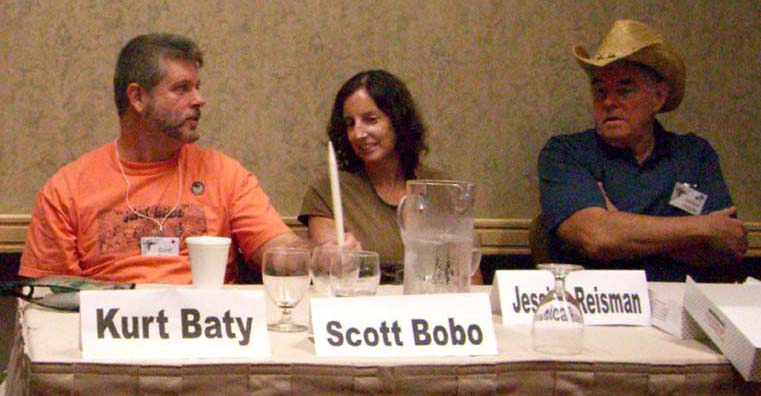
Jessica Reisman: it’s a rocket for very small men.
Scott Bobo: it’s a Charles Stross rocket! (I guess he refers to the Coke-can sized spaceship in Charles Stross’s story Halo. — E)
James P. Hogan: it’s a sex toy.
There is a box of donuts lying on the table. Bradley Denton picks up a donut and says: I’m thinking this goes with it!
Object 2: clip-on sunglasses
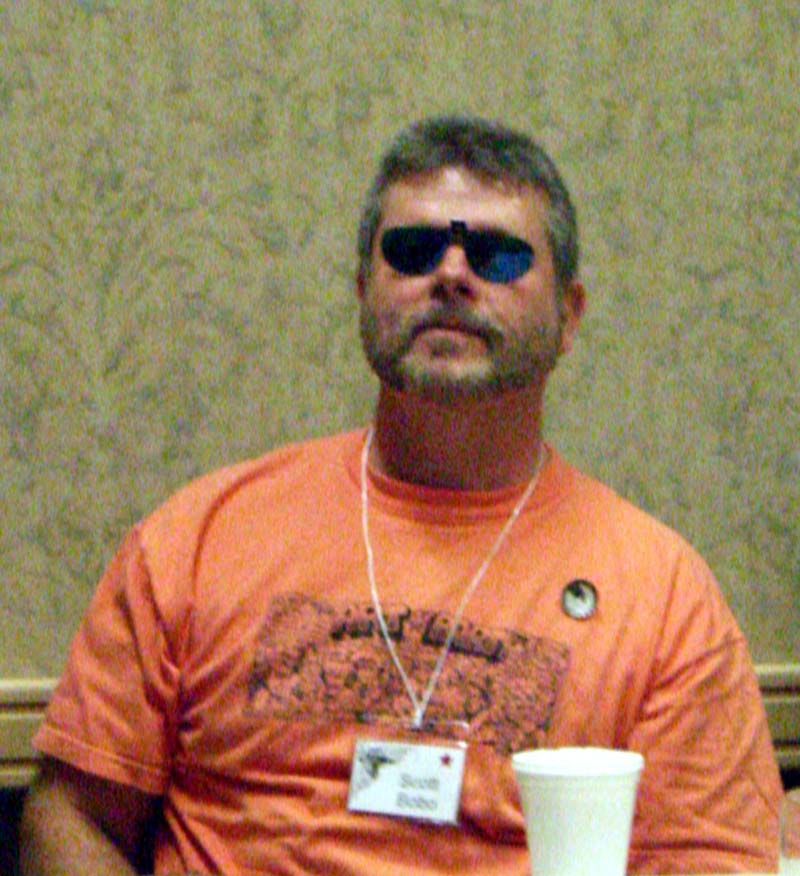
James P. Hogan. You use a knife-edge balance to measure radiation pressure. It’s a full-spectrum measure of radiation. That’s why it’s black.
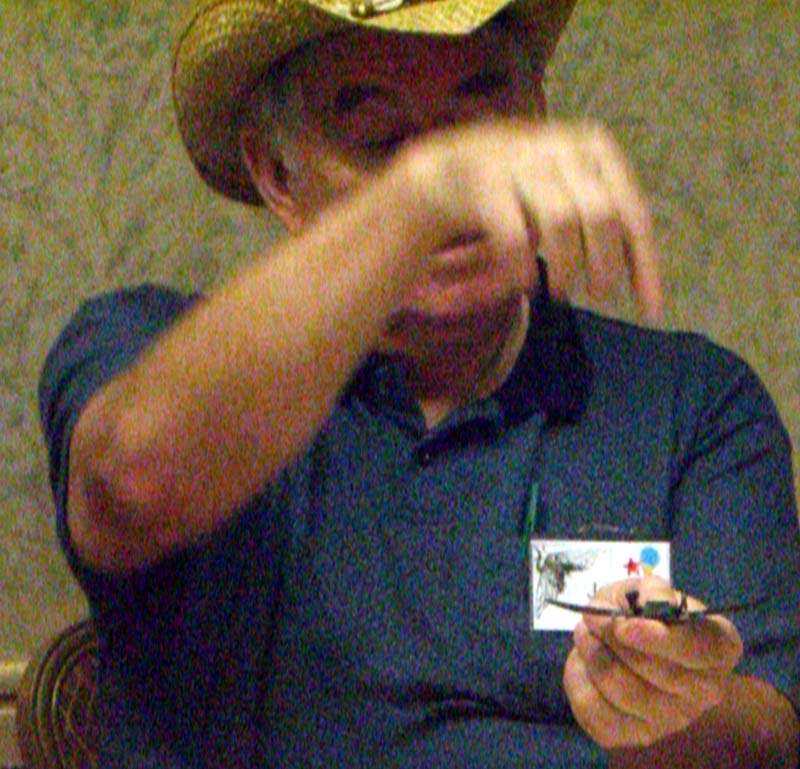
Bradley Denton. It’s some kind of antenna, because it swivels back and forth.
Jessica Reisman. It calibrates the signal.
James Hogan. Yes, here we are. You can shine a radiation beam on each one, and you can calibrate the radiation beam to a standard. The reason it’s black is because it absorbs the whole wavelength.
Object 3: a swiss knife
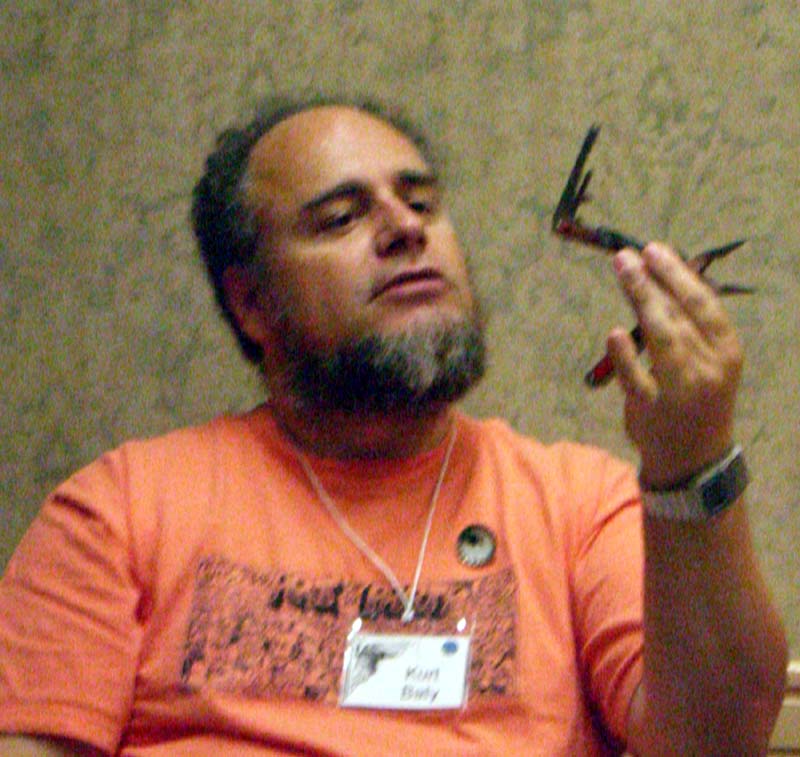
Kurt Baty. What would an alien culture make of it?
Jessica Reisman. Similar to the tools we have for cracking lobster, this is a tool aliens use for eating humans. Each of these appendages is for cracking a different part of human anatomy. For prizing out various bits of delicacies.
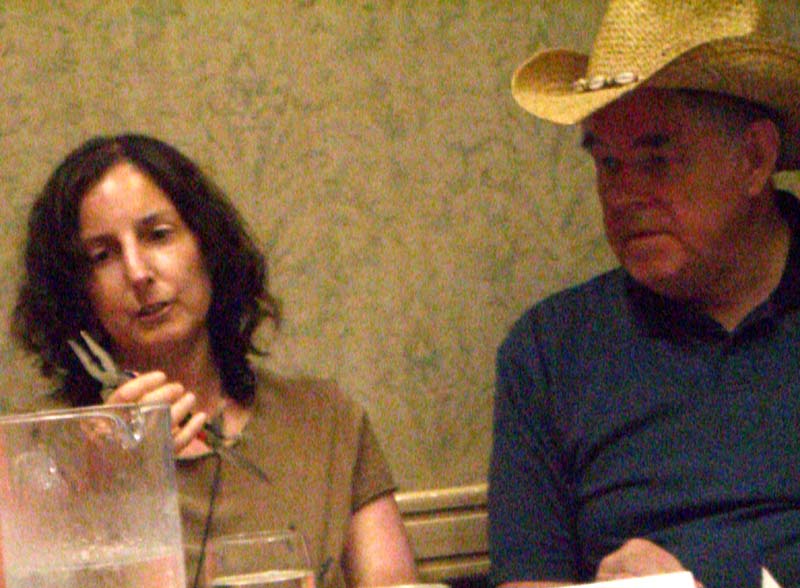
James P. Hogan. This thing comes from a planet with a low density atmosphere. The communication among its inhabitants is mostly by visual means [because sound does not propagate very well in low density atmosphere]. They were octopoids. They had seventeen tentacles. They communicated in semaphores [by forming various postures with their tentacles]. As a result, their written language is pictograph-based. They developed an enormous collection of pictographs. So when they started developing clay tablets, the impressed pictographs on them. This was an all-purpose writing tool that could have been configured to represent all kinds of pictographs. It was their equivalent of an electronic notepad.
In an advanced model you could insert springs and catches, so that it would leap into a desired position.
Bradley Denton. This is fascinating. When I was kid, they called this a Texas crib toy. In Texas, when you have a child, you would toss one of these in a crib when a child is 6 days old, and every hour you would check what the kid has done with it, and that’s how you would find out what the kid is going to grow up wo be: a carpenter, or a run-of-the-mill redneck axe murderer. This device is how “hook’em horns” symbol came about.
James Hogan picks up his thought and runs with it. Toys’r’Us should be selling cutthroat razors, so as to eliminate not-so-smart kids. Because dumb kids grow up and make more dumb kids. (I’m pretty sure this was a joke. — E.)
Object 4: something that dangles on a chain, resembles a key.
I could not get a good picture of this object no matter how I tried. Perhaps it… didn’t… want… to be photographed? So this is the best I got.
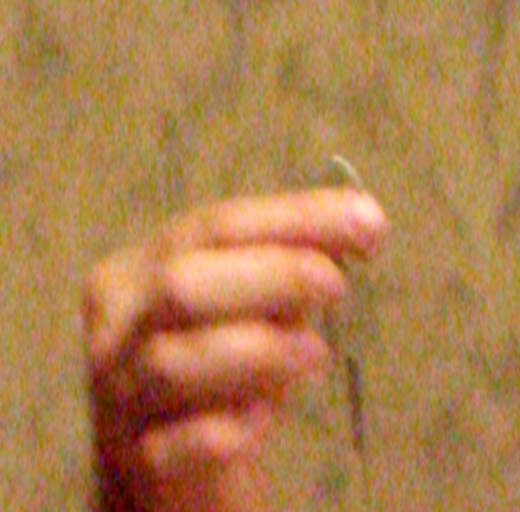
Jessica Reisman. It’s a whistle of some sort. Nobody would care to hear it. (She pretends to blow it, and the panelists cover their ears and scream, even though no sound comes out.)
James Hogan. It’s the ultimate in nanotechnology. Erwin Schroedinger asked the question why are we so big. Why do we have all those countless trillions of atoms? What do we need them for? If we were nanoscale, we would have […] thriving economy. So there was a civilization that set out on a nanoscale approach to civilization. They became extinct, and this is, in fact, one of their starships.
He points out a section that rotates in flight. It’s a ramscoop, he says.
Renee asks from the audience: you don’t think there are any little nano people in there right now?
Brad Denton. Not after he just blew them out.
Brad Denton. [I guess this spaceship crash-landed in Kansas], because when I was a student in the university of Kansas, this was one of the membership keys in Phi Beta Zed. Phi Beta Zed was not the sharpest honor society on the planet. But now that I know this is an alien spaceship, that would explain a lot of flame-scorched nostrils I saw.
Then someone (Scott Bobo?) asks who this item belongs to and what it really is. A guy from the audience, the owner of this item, says it’s a handcuff key. With this key you can remove handcuffs while you have them on.
Object 5: a business card holder
Kurt Baty. This next artifact will definitely cause some excitement. It appears to be steel, but it’s definitely looks like it’s nickel silver plated, because I can see the copper underneath. In order to plate steel, you plate the copper first, and then the copper is exposed to a plate of nickel silver. [?] I can tell it’s nickel silver because it has a […] of silver oxide on it. That’s what causes tarnish. It’s seen some use. I don’t think it’s a virgin case here by any stretch of imagination. But why would you need such a fancy elegant case for business cards, if you can use the plastic ones?
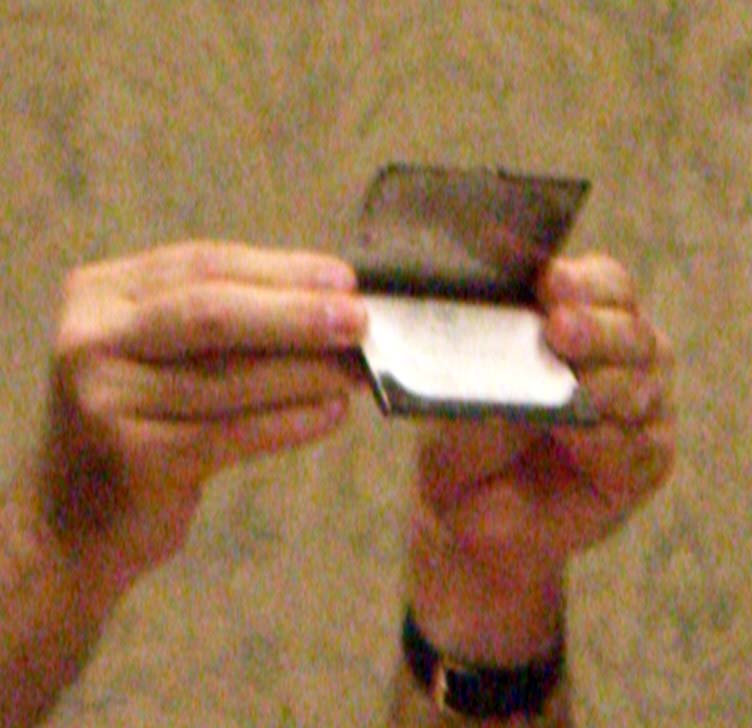
Scott Bobo points out the intricate design on the surface of the business card case.
A guy from the audience. Is that a sarcophagus for flatlanders?
Someone else. A LOT of them.
Scott Bobo. It’s a reality library. I think any of these cards is a card that lets you enter a reality you choose.
James P. Hogan. I’m gonna demonstrate that I’m not compulsively adversarial. On this occasion I will agree that it is a sarcophagus, but first, a little background information. It comes from a high gravity planet. [He says something about having seen fascinating papers that say gravity is a byproduct of electromagnetic forces, or something like that. But I may have misunderstood. He then says something like: The electromagnetic force has a slightly asymmetrical residue that attracts at 40 orders of magnitude less than electrical force, and that describes gravity exactly.]
James P. Hogan. When they (the aliens?) were alive, electrical polarization of molecules keeps them distended, but when they die, they collapse. So these cards in it (the business card holder) are aliens.
Bradley Denton. There’s no way I could argue with an explanation that’s so scientifically correct, but once again, these aliens must have been blown into space and landed in Kansas, because…
Object 6: a chewing gum holder
Bradley Denton. I think this obviously from the same planet as the previous device, but it is sadly for an infant.
James P. Hogan says that this is from a planet where the inhabitants are invertebrates and they are gooey and mucky. This is a scabbard of their sword. (The latter does not automatically follow from the former, but I think there was some part of Hogan’s reasoning that I missed. — E.)
Jessica Reisman. They might have been what they are used for there, but originally they came across a great cache of them, in one of the upper deserts. What they’re really are is naturally forming organic lollipops.
Scott Bobo doesn’t say anything. He holds up the gum holder and sings a few notes from Space Odyssey, pretending it is a black obelisk.
Scott Bobo, ominously. Nobody has actually pointed out that there are cryptic… symbols… on it.
Somebody. It could be a symbol pointing to the center of the universe.
Scott Bobo. Yeah, that’s what the warning label says.
Kurt Baty. It has a secret scabbard that protects it from environment.
Scott Bobo. It is a parking garage [?]
A woman from the audience. It’s a digital harmonica.
Another woman. No, it’s a torture device from a planet Catonia [?]
Object 7: a flapping thing
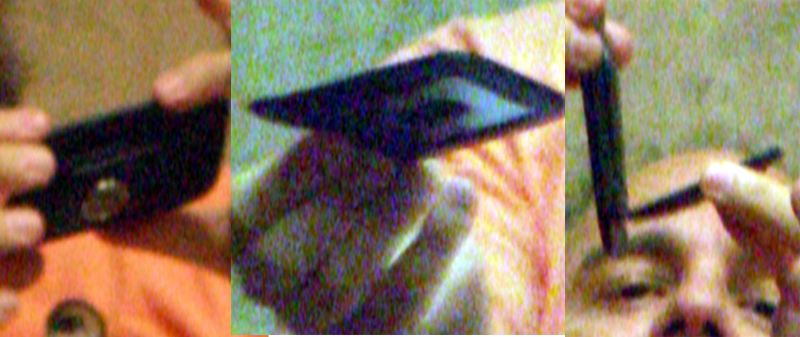
Kurt Baty. This one puzzles me a bit, because it’s too thin to hold a cell phone or a pager. I wonder if it’s a badge of some kind. It’s very thin. If somebody’s got a thinner phone than mine, I’m impressed. A badge, some sort of work badge? It’s got a magnetic catch that’s very nice, on the back. But interestingly the magnetic catch is upside down, which means you think you wear it on something like that, but then you can put it upside down [….] I’m kind of at loss as to what it is. Maybe the panel at the other end will be able to edify us there.
Jessica Reisman. It has a symbol of the world on it, so it’s an all-purpose tool for an interplanetary agent who was assigned to Earth and lost his tool. He’s clearly in a lot of trouble.
James P. Hogan. I think it’s a remote-operated mouse trap.
Then he changes his mind. He says something about fuzzy aliens, and that they have a mating ritual where females use cheese to attract males. “Hey big guy, hey big guy, what you’re doing?” (as in the image below) and then the trap springs.

Brad Denton. I thought this was a pop tart cooker. And you can carry it around, and when you’re ready to cook a pop-tart cook, you flip it down, and the heating element […] pop-tart is ready. But I agree that it could also be an erotic trap.
Jessica Reisman offers to demonstrate one of the uses of this all-purpose tool. You can put very thin cards into it, and you take out the card, and point it to somebody, and… (I’m not sure what was supposed to happen next — E.)
Scott Bobo. They are all wrong. It’s a portable vacuum cleaner. (I’m sure he explained why he thought so, but I missed that part. — E.)
Kurt Baty. Whose is it?
The guy from the audience who supplied that item shows that it’s a money clip with a window for an ID card. He says that whenever he shows his ID to a cop, it comes back with the money gone.
Object 8: a Compact Flash drive
Kurt Baty is much more impressed with the real-life technological capacities and significance of flash drives, than with their possible science fictional uses. He does not pass an opportunity to tell us all about the amazing technological achievements that enable us to carry the Library of Congress on a keychain. But they are supposed to talk about science-fictional uses, aren’t they? (I’ll leave what Kurt said just for the sake of flavor, but the next two paragraphs can probably be skipped. — E.)
Kurt Baty. This is as science-fictional as anything that’s been written about. This is a Compact Flash disk, USB, 128 megabytes, was probably given away, I bet… Trade shows these days, they just give them out. 128 megabytes! I just re-read Mr. Hogan’s “Thrice Upon A Time”, it’s a wonderful time paradox, a tour de force time paradox novel. However, in 2010 this novel predicts that a computer will have to allocate 50 MB on the net, because it won’t have that much memory. And here’s a 128 on a stick. And this is not state-of-the-art!
Compact Flashes store bits by having floating pieces of silicon in the memory cell, and they tunnel electrons onto that piece of silicon, and that piece of silicon is called asperity (?). The state of the art Compact Flash is 4 GB. They are pushing up to 8 GB, will soon be 16. They are probably fabbed at .18 and are moving down to .065 (Kurt gives more technical characteristics). And the size of the piece of silicon they are storing the electrons on is so small, that they can’t put enough electrons there to go back and read it out again, so they have to etch it vertically into the surface of the silicon. […] They have to go vertical on the asperities in order to make them large enough to store the electrons to have enough electrons to read out later. And that’s where the technologies are right now. They’re struggling to get the vertical channel asperities to work on Compact Flashes.
Someone from the audience: oh, come on, what is it really?
Scott Bobo. It’s a chick magnet, baby. (He hangs it around his neck and makes a pun on memory stick that’s supposed to serve as a pickup line.)
Jessica Reisman. Actually, it’s even more futuresque than that. It looks like Compact Flash, but what it really is is a compact makeup and contraceptive kit for a woman from the future. She can set it to do whatever she needs to do. She uses the little wand for all sorts of things: to apply makeup, and when you close it it disinfect the wand, and resets it to deliver a contraceptive shot. And it has a disk on it so that it could be carried by your cyber Saint Bernard.
(It’s also a digital Mace, she adds later.)
James P. Hogan goes on to tell about an electroconductive life form. Their whole body is a distributed processor. Radio communication is one of their faculties. Being an electroconductive life form has its own advantages. For example: you go to the picnic and want to cook a chicken, you just connect it to the car battery. This (he’s talking about the flash drive)is, quite simply, a pasta cooker. You connect loops of spaghetti, press a button, 30 seconds and it’s done.
Brad Denton. What it really is is a remote control for internal suicide device. Whenever you come across people who are more clever than you are, you just point it to your head and press the button.
Object 9
Nobody knows what it is, or pretends not to know.
Scott Bobo. It’s one of those flat things. [Flat objects are very popular on today’s panel.] Are they all high gravity objects, or what? But there used to be a liquid right here. I think you can see it, a yellowish thing. And there is a bubble. My preliminary observation is to say, I think this is an aquarium. I think this is some kind of aquarium, I’m just not sure what. There’s a little bit of air supply, for maybe a mammal or something. I think there is some more things on it, that maybe Kurt discovered.
Scott pulls out a measuring tape from that thing.
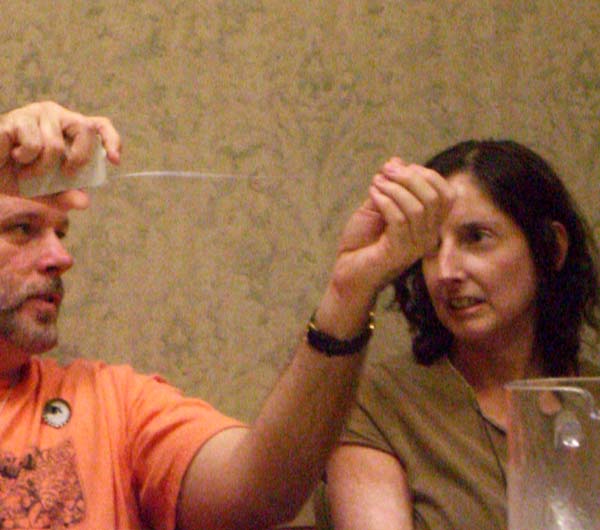
A guy from the audience. You got him excited! (Everybody laughs and claps.)
Bradley Denton. You say things that we think but don’t say!
Somebody. […] it might grow? A lot more, perhaps? Oh, it vibrates as it approaches!
Bradley Denton. I’m not sure what it is, but now you can’t take it on an airplane.
Scott Bobo. In the top part there’s a little bubble moving back and forth through the liquid. There’s an entire tiny city inside the bubble. They put up a huge banner! (He pretends to read:) “Please, God, make this end soon” If they ever find the way out of the bubble, they have an exit ramp (he pulls out the measuring tape).
James P. Hogan. It’s a prototype of artificial DNA. The numbers along here (I think he’s talking about the measuring tape — E.) are genetic sequence coating. It doesn’t fold up the way proteins do, but rolls itself up inside it. It is genome for self-reproducing robots. You just plug it in and [it reproduces]. It’s taking AI research to its next step.
He adds: We are wondering why we put this ingenuity and money to create robots that think like people, when we still have educated people who think like robots. It’s much more fun to create human intelligences: it takes two people and 9 months. It’s more fun than to assemble them in factories.
Jessica Reisman, going back to the item in question. It’s tongue depressors for some very strange aliens. It takes some certain body chemical levels.